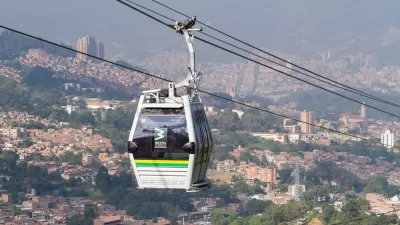Steve Rose surveys the scene at this year's Architecture Biennale in Venice, where he observes that the mood has shifted: "away from starchitecture towards something quieter, more collaborative and utopian."
According to Rose, this year's Biennale - regularly the most important event on the architectural calendar - reflects the new reality for a field trying to regain its footing following the crash of the high-flying real estate market of the 2000s.
"The theme for this year's Biennale, chosen by its British director David Chipperfield,
is Common Ground. It's a choice that hints at architecture's need to
refocus on issues like engagement and communication, on its need to
establish shared values. But as the Spanish students show, there are
chasms splitting the world of architecture. A divide is opening up –
generationally, economically and philosophically. The starchitects of
Trujillo's second reality are still here, but the appetite for
celebrations of individual genius, and isolated, beautifully crafted
buildings, seems to be dissipating. To co-opt the language of the Occupy
movement, the big names are starting to look like architecture's 1%."
In the search for stable ground, architects are gazing backwards to the mid-20th century when the pendulum had firmly swung in the other direction - away from designing and developing the trophy homes and buildings for the global 1%, and towards a social utopianism.
"Those were the days: when architects knew what needed to be done and
governments had the money to let them do it," says Rose. "Dutch superstars OMA,
for example, celebrate the work of anonymous architects in public
authorities across Europe from the 1960s and 70s. As OMA architect Reinier de Graaf
puts it, the era was 'a short-lived, fragile period of naive optimism –
before the brutal rule of the market economy became the common
denominator.'"
FULL STORY: Starchitects and squatters: Venice Architecture Biennale

Planetizen Federal Action Tracker
A weekly monitor of how Trump’s orders and actions are impacting planners and planning in America.

Map: Where Senate Republicans Want to Sell Your Public Lands
For public land advocates, the Senate Republicans’ proposal to sell millions of acres of public land in the West is “the biggest fight of their careers.”

Restaurant Patios Were a Pandemic Win — Why Were They so Hard to Keep?
Social distancing requirements and changes in travel patterns prompted cities to pilot new uses for street and sidewalk space. Then it got complicated.

Platform Pilsner: Vancouver Transit Agency Releases... a Beer?
TransLink will receive a portion of every sale of the four-pack.

Toronto Weighs Cheaper Transit, Parking Hikes for Major Events
Special event rates would take effect during large festivals, sports games and concerts to ‘discourage driving, manage congestion and free up space for transit.”

Berlin to Consider Car-Free Zone Larger Than Manhattan
The area bound by the 22-mile Ringbahn would still allow 12 uses of a private automobile per year per person, and several other exemptions.
Urban Design for Planners 1: Software Tools
This six-course series explores essential urban design concepts using open source software and equips planners with the tools they need to participate fully in the urban design process.
Planning for Universal Design
Learn the tools for implementing Universal Design in planning regulations.
Heyer Gruel & Associates PA
JM Goldson LLC
Custer County Colorado
City of Camden Redevelopment Agency
City of Astoria
Transportation Research & Education Center (TREC) at Portland State University
Camden Redevelopment Agency
City of Claremont
Municipality of Princeton (NJ)




























